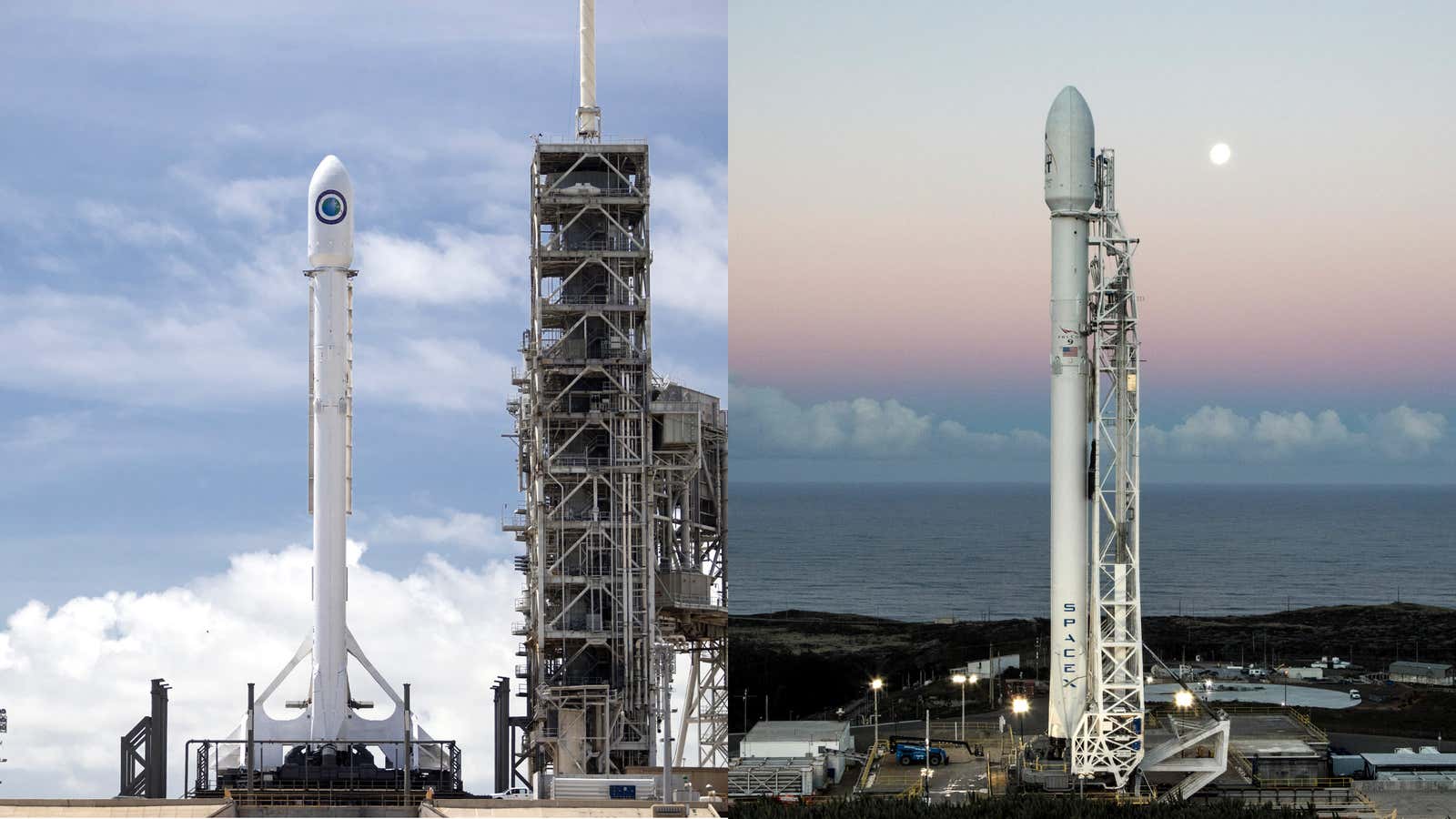Elon Musk’s rocket company SpaceX has a busy weekend ahead, with two launches on opposite sides of the US scheduled for June 23 and June 25.
If successful, the two missions—the eighth and ninth Falcon 9 launches of 2017—will show off SpaceX’s ability to launch more frequently than its competitors and allow it to win more multimillion-dollar launch contracts. SpaceX is on track to launch more rockets than its competitors in a calendar year for the first time ever.
Another important demonstration will be of SpaceX’s ability to reuse rocket boosters that have already flown, making launches cheaper and accessible to more clients. One of the launches will be only the second time a previously-flown commercial rocket booster has been reused. The other will use a brand-new rocket. But in both cases, the company aims to land the boosters on autonomous sea-going platforms for future reuse.
Two launches in 48 hours by the same operator is a rare occurrence. The last such feat was in March 2008 by one of SpaceX’s chief competitors, United Launch Alliance, which flew an Atlas rocket and a Delta rocket. But ULA is a joint venture of two aerospace companies, Boeing and Lockheed Martin, that had previously launched those rockets independently.
To do the same as a single company, SpaceX has invested in separate launch teams at Cape Canaveral in Florida and Vandenberg Air Force Base in California. Each is complete with its own launch director, technicians, and recovery teams who manage the autonomous ships assigned to each site. A few launch team members with overlapping responsibilities on both missions are expected to work the second launch from the Cape’s launch control center.
BulgariaSat—June 23
The first launch is at Kennedy Space Center in Florida, where SpaceX will launch Bulgaria’s first ever geostationary satellite, named—what else?—Bulgariasat. This will be the first privately-owned satellite to provide broadcast and communications services to eastern Europe, hanging in an orbit directly over the region. Maxim Zayakov, the CEO of Bulsatcom, which owns the satellite, says a “flight-proven” booster, as SpaceX calls it, not only made the project cheap enough to be possible—he even sees it as an advantage. “Basically, a booster that already flew once, as long as it is checked, is actually in our view more flightworthy than a brand new one.”
The launch had been planned for June 19, but was delayed after engineers found a faulty valve in the system used to release a protective nosecone, or faring, when it’s time to deploy the satellite into orbit. After launch, SpaceX will attempt to land this booster on a drone ship in the Atlantic ocean so it can be used a third time. Its previous flight was in January of this year, carrying 10 Iridium satellites, and this launch will make it the first rocket booster ever to fly from both US coasts.
Iridium Next—June 25
This launch carries the next 10 satellites in a 70-satellite, seven-rocket deal Iridium has made with SpaceX. The mission is flying from California because these satellites are designed to sit in a polar orbit, arrayed north to south around the globe, rather in the equatorial orbits used by many satellites that are launched from Florida. Iridium is fond of referring to the suite of launches, which will effectively replace its entire existing satellite constellation, as one of the largest “tech upgrades” in history.
The launch is expected to replicate the January launch that put up the first 10 satellites in the sequence, complete with a landing on a robotic barge in the Pacific ocean, according to Iridium’s CEO, Matt Desch.
Desch is exactly the kind of client that SpaceX wants for its flight-proven boosters. So far, he hasn’t signed Iridium up for any, saying that the cost difference—about 20%, or $18 million between a new booster and re-used one—isn’t worth the risk for satellites worth tens of millions of dollars, plus insurance premiums.
But reusable boosters have one other advantage in a launch market where there’s still more demand than supply: They’re quicker to get ready for the next launch. That could tip the balance in their favor for Desch, he reportedly said on a recent press call. “Will they improve my schedule? Because schedule to me is very very important.”
That’s true across the satellite industry. Companies invest large sums up front to build satellites, which are repaid only once their birds are in orbit and operating. Time spent in warehouses waiting for a launch is money lost. SpaceX’s growing stockpile of flight-proven rockets could prove an attractive inducement for otherwise hesitant new customers. But only if it can keep up its steady pace of launches on both coasts; three more missions are on the manifest in July.
